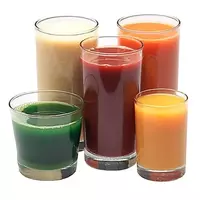Juice

How long a person lives on earth, for so long he consumes foods of plant origin. So, one of the most common ways to use fruits and vegetables is the juice that is made from them. Juice is a liquid that is obtained from edible ripe fruits by squeezing. In addition to fruits and vegetables, stems, roots and leaves of various edible herbs are often used. You can get juice from some types of trees.
In cooking, the beneficial properties of juice are highly appreciated, where it is used not only to directly quench thirst, but also to prepare all kinds of cocktails, necks, drinks with it, and also add it when preparing many dishes and desserts.
Types of juices
From a consumer point of view, there are a huge number of types of juice, which differ depending on the source raw materials. So, for example, there are fruit and berry juices, among which the leaders are:
apricot juice;
pineapple juice;
orange juice;
grape juice;
cherry juice;
pomegranate juice;
lemon juice;
plum juice;
apple juice.
In addition, juices from vegetables are in no less demand, the most popular of which are carrot and tomato juice.
And in some countries there is a tradition of extracting juices from trees. In Russia, for example, birch juice is very popular, while in Canada maple juice is produced, which goes to make the world famous maple syrup.
Many do not unreasonably believe that freshly squeezed juice, which is obtained immediately before consumption, is considered the most useful. In addition, two more types of juice differ depending on the process of their manufacture: directly squeezed juice and reconstituted juice. The first is pasteurized and then poured into containers, while the second is made by diluting the concentrate with water and then packing.
Juice composition
The composition of the juice directly depends on how it is prepared. It is clear that in the freshly squeezed product, in addition to the juice itself, there can be nothing, but with other species it is different.
Almost always, an exclusively reconstituted product goes on sale, therefore, in the juice composition you can find concentrated puree, which is prepared from the starting material, sugar syrup, ascorbic or citric acid.
Juice benefits
The benefits of juice are obvious only if it is a really natural freshly prepared product, in which all the valuable substances of vegetables and fruits are preserved. The use of such juices contributes to the preservation of beauty and health, an increase in the level of human energy, as well as the flexibility of the joints.
In addition, despite the unconditional value of vegetables and fruits, the benefit of juice is that it is a product that is absorbed by the body much easier and faster due to its high water content. And the calorie content of the juice is quite often lower than, in the fruits of which it is prepared.
Juice harm
With regular consumption of this delicious product, it should be remembered that the benefits and harms of juice are separated by an invisible line. For example, the abuse of juice can cause various allergic reactions, indigestion, diabetes or diseases of the pancreas.
juice 60 kCal
Energy value of juice (Ratio of proteins, fats, carbohydrates - ju):
Proteins: 0.7 g (~ 3 kCal)
Fats: 0.1 g (~ 1 kCal)
Carbohydrates: 13.2 (~ 53 kCal)
Energy ratio (bj | y): 5% | 2% | 88%
 Español
Español Français
Français Português
Português Русский
Русский 简体中文
简体中文 繁體中文
繁體中文 日本語
日本語 한국어
한국어 العربية
العربية Türkçe
Türkçe Қазақ
Қазақ Deutsch
Deutsch Italiano
Italiano Українська
Українська
